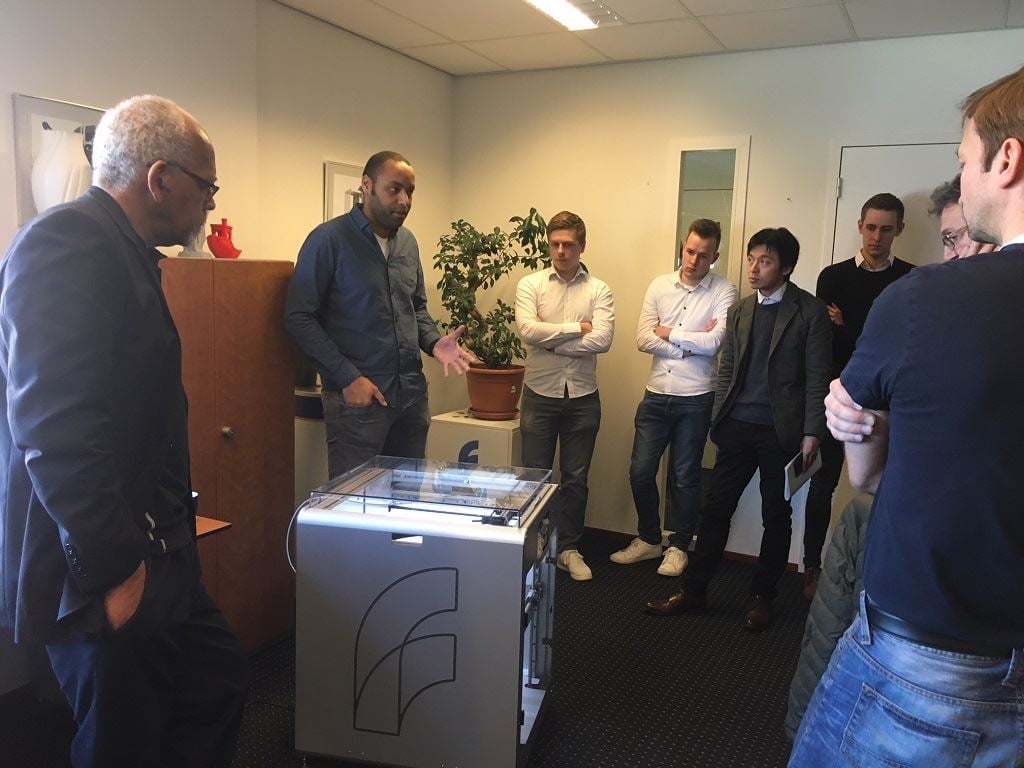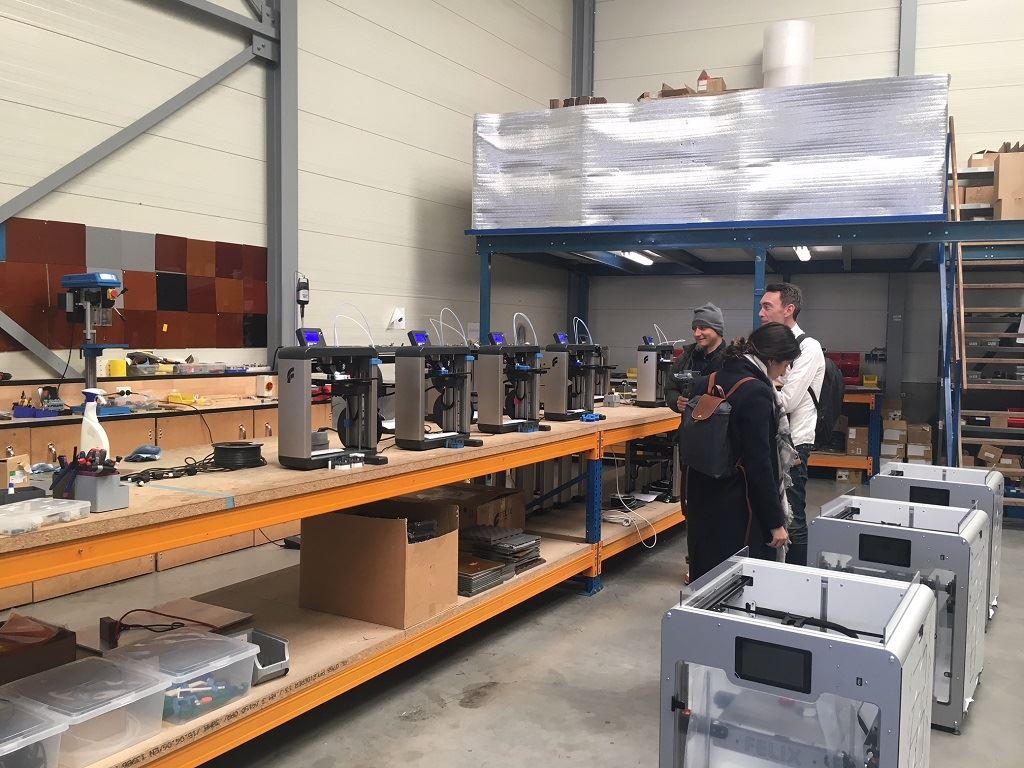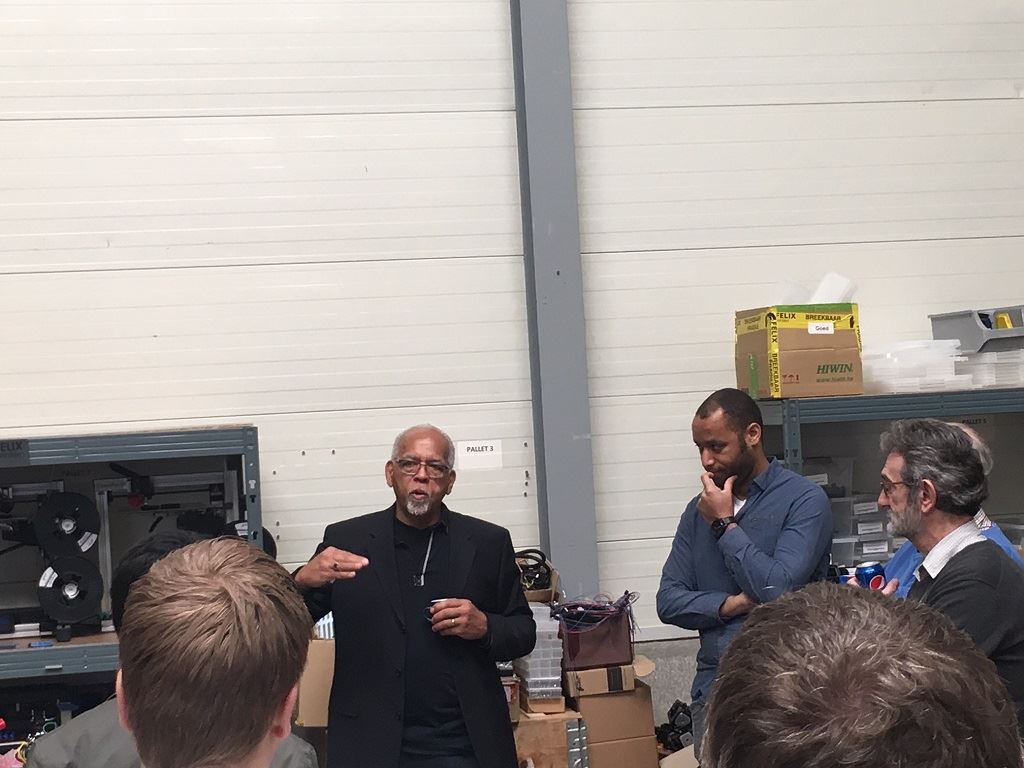![Wilgo (gesturing) and Guillaume (center right) discuss FELIXprinters strategies [Image: Rachel Park]](https://fabbaloo.com/wp-content/uploads/2020/05/IMG_48781_img_5eb09a00bee61.jpg)
Bringing people together to understand its business was the key motivation behind FELIXprinters opening up its HQ facility and factory based in the Netherlands on April 1.
That and the official launch of the FELIX Pro L & XL models. A diverse mix of reseller partners, customers and some key members of the press were invited to Ijsselstein, near Amsterdam, to witness first-hand the innovation and ethos of the company and its dedication to high-quality and reliable 3D printers.
Indeed, these values are at the very heart of this family-run business: Wilgo (father) and Guillaume (son) Feliksdal lead this company from the front, as co-founders and directors of FELIXprinters. As Guillaume highlighted in his presentation to the gathering, the origins of the company date back to 2007 when, as a new graduate, he undertook a project that he believed would benefit from 3D printing — the development of a humanoid robot. Attempting to use any 3D printer that was accessible to him, however, proved frustrating in terms of the quality of output and the reliability of the system. He went on to solve some of these issues for himself and FELIXprinters was born in 2010.
![[Image: Rachel Park]](https://fabbaloo.com/wp-content/uploads/2020/05/IMG_48431_img_5eb09a01171c6.jpg)
It is hardly an unfamiliar story within 3D printing, whereby desktop FFF — also commonly referred to as FDM — platforms do not meet the expectations of users and cause frustration, particularly back then. There are also other, albeit fewer, stories of people who took this frustration and used it to take 3D printing to the next level themselves.
And this is what FELIXprinters has done, somewhat quietly to date, it has to be admitted, although now things are changing as the company makes sustained moves into the industrial 3D printing market. Frequently, the big name brands in this market sector do tend to get the bulk of media attention, those with big PR machines behind them and marketing budgets that ensure editorial attention. Similarly, companies with strong open source heritage and greater longevity get talked about more on social media.
However, this can overlook, sometimes even negate, what a small and dedicated company like FELIXprinters can bring to the sector with serious and meaningful innovation through attention to detail in technology development, combined with tailored customer service and long-term loyalty to customers through upgrade options and true modularity.
Overview of the Day
After a welcome address to the audience from Wilgo, Guillaume went on to provide the audience with a historical overview of the company as outlined above, and explain FELIXprinters’ mission and vision, including its current activities and future goals.


[Images: Rachel Park]
The core FELIX team operates out of the Netherlands facility and is dedicated to R&D, technology development, production, assembly and after-sales activities. The company also develops key, specific partnerships for sales, marketing and other activities. FELIXprinters works with a global network of more than 40 resellers. Guillaume highlighted the mission of FELIXprinters specifically to operate as “a technology supplier, strategic partner and guide for unlocking the potential of 3D printing applications — large or small.” He also specified the core values of the company, namely its innovation and attention to detail, quality in production and output, and the reliability of this output in terms of operation and repeatability. This message was delivered without fuss and fanfare, but left the room in no doubt that these values run through the operation and are what drive this mission towards reality, one application at a time. The dignified passion from the father and son team was unmistakable and really hit home.
Of course, these terms — innovation, quality, reliability, repeatability — are common buzzwords across 3D printing land and they are somewhat overused in marketing campaigns — because it’s what users want, need and often demand. Some companies can back the words up with their platforms, some just can’t, but they keep saying it anyway. It’s an issue, but not one for now.
From what I know about this company (see disclaimer below) FELIX belongs to the former group. Moreover, the resellers and customers that were on-site at the open day, were all, unprompted, saying similar things. These were users and resellers that have broad comparison bases, that were and are impressed with the quality platforms that FELIX delivers, backed up by lengthy warranties and an equally high level of after-sales service. Across the day, I spoke with numerous individuals who conveyed real trust in what FELIXprinters are doing, and, to be honest, it was gratifying.
On the day, FELIXprinters also announced that it has added another valuable service for supporting European customers with the introduction of an installation service. This includes the delivery of the 3D printer(s) to any destination in the Netherlands or Belgium (with plans to roll it out across mainland Europe); installation of the hardware and software, performing test prints and training to ensure the printer is fully functional at optimum quality.
Even as Guillaume (with occasional interjections from his dad) explained FELIXprinters’ transition over the last 12 months to focus on more industrial applications — evident through the current 3D printer models in production (Tec 4 / Pro 3 / Pro L and Pro XL) — he was categorical in his insistence that the USPs of the company remain unchanged, specifically that modularity, through the ongoing ability to upgrade any FELIX 3D printers remains in the company’s DNA. Here he cited customers that are still using FELIX 1.5 3D printers (introduced 6-7 years ago) successfully, with upgrades, and the company still provides the same level of service and spare parts. It is this commitment and loyalty to their customers that really does stand out.
Another area where FELIXprinters is able to distinguish itself within the market is its development of customised 3D printing platforms and complete solutions. Although the current projects that the team are working on with key partners are still sensitive in nature, Guillaume was able to comment, in generic terms, on the sectors where they are developing custom platforms, namely for biotech, academic research and food applications. The latter in particular has reached critical mass and has been extended to include 10 more fully automated platforms in the coming months. Platforms here is not “just” a printing platform, but rather an automated system for pre- and post-loading, and offering continuous operations. At this point, Wilgo was unable to contain himself in revealing more about the opportunity this has presented FELIX, working with “one of the largest food operations in the world, [which] has chosen FELIX for quality and reliability.”
They’re really proud of what they’ve achieved to date. Moreover, the success of this project is informing FELIXprinters’ activities in other sectors and the IP that has been developed can be rolled out into other areas.
The stars of the day, however, were the new large 3D printing platforms that FELIXprinters has developed and officially launched — the L and the XL. These two new platforms open up new opportunities for larger industrial parts in a range of industries. A couple of the resellers present were effusive in their anticipation of getting these 3D printers into the hands of some of their automotive clients in Germany. “We have supplied some larger platforms from other vendors, with mixed results,” one informed me. “There were lots of issues, but these machines, knowing what these guys do will make a big difference for us. We’ve tested it and it does what they say it can. The quality and service is what our customers want. And we trust FELIX to deliver.”
![[Image: Rachel Park]](https://fabbaloo.com/wp-content/uploads/2020/05/IMG_48831_img_5eb09a01d4c32.jpg)
Parts off the two large platforms were scattered around the office and factory, a visual representation of their capabilities. Some were aesthetic — eye-catching in colour and size to make a point — others did not catch the eye so quickly because they were functional (read boring) in looks, but they were equally, if not more, impressive. They were well handled and closely examined all day. During the tour of the factory, a couple of the large machines were in operation, unmanned and untroubled. Others were obviously in production across the factory floor, alongside the production lines for the more familiar, desktop-sized Pro 3 and Tec 4.
![[Image: Rachel Park]](https://fabbaloo.com/wp-content/uploads/2020/05/IMG_48611_img_5eb09a021fd93.jpg)
Guillaume announced that an upgraded Tec platform — the 4.5 — would be available by the end of this year, indicating that while the company is now industrially focused, its heritage continues to inform its evolution. As I continue to learn and understand FELIXprinters, my takeaway from the open day event is that the company has always focused on little things that make a big difference, and continue to do so but they are now also doing bigger things — literally and figuratively.
Disclaimer: In her role as consultant for PYL Associates, Rachel is working with FELIXprinters on strategy and content development. She has not paid or received payment from Fabbaloo for this article.











FELIXprinters has released a new bioprinter, the FELIX BIOprinter, which is quite a change for the long-time 3D printer manufacturer.